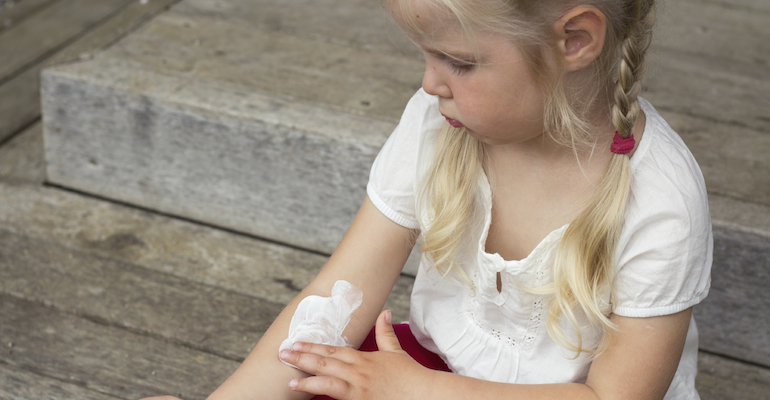Eczema, also known as atopic dermatitis, is common in children. The symptoms include dry skin with a chronic, itchy rash, often accompanied by irritability and problems with sleeping and eating. Studies show that 10 to 20 percent of all children are affected by this ailment at some time during childhood, and boys and children of Asian or African ethnicity are particularly likely to develop eczema.
Most children begin showing signs of atopic dermatitis at two to three months of age — the itchy rash appears on the elbows and knees, as well as around the neck and on the face. Scratching the rash can leave skin open and prone to infection, causing further damage. Some older children and teens actually develop thickening of the skin in the folds of the elbows and knees due to chronic scratching.
Unfortunately, for many children this is a disease that comes and goes, but never disappears entirely until adulthood. Treatment won’t cure the dermatitis — it just eases the itch and makes the child more comfortable.
The cause of atopic dermatitis is not known, but heredity and environment both seem to play a role. Children with eczema can’t tolerate climate extremes: Humidity causes sweating, which exacerbates the rash, and dry air worsens the dryness in the skin. Some children may break out when their skin comes in contact with certain soaps or detergents, wool clothing, perfumes, and chemical irritants. Diet may also be a factor, and eating certain allergy-provoking foods — eggs, cow’s milk, wheat, soy, and peanuts — might worsen the eczema.
Skin Care for Children with Eczema
Keeping atopic dermatitis under control requires taming the itch and rehydrating the dry skin through daily treatments, even when the symptoms aren’t particularly severe.
Experts suggest soaking the affected areas in lukewarm water for five to 15 minutes once or twice each day. A small amount of bath oil or mineral oil can hydrate the skin; baking soda can help with the itch, but it will dry the skin even further. Use as little soap as possible, as that can also dry the skin. Moisturizing soaps (preferably unscented) and mild shampoos, such as baby shampoos, are best for cleaning skin without drying it.
After bathing, the child should be patted, not rubbed, dry with a towel. Before the skin has dried completely, a heavy-duty, greasy moisturizer should be spread onto the child’s entire body. This may be an unscented petrolatum jelly or a cream-based moisturizer. (Avoid using lotions, which aren’t as effective at sealing in the moisture.) The moisturizer should be applied two or three times a day to seal in the skin’s natural moisture.
Treating the Symptoms
For flare-ups of redness and inflammation, many health-care providers prescribe corticosteroids in cream or ointment form to stop the itching. These medications may cause scarring if used too frequently, so they should be used only as directed. Experts recommend applying steroid cream right after a bath, then applying moisturizer over it. Ointments are often better for children of Asian and African descent, as they help the skin to retain moisture more than creams do.
If your child’s dermatitis is severe, you may need more than steroid ointments to control the itch. Many physicians suggest oral antihistamines or one of the new immunomodulators, which are approved for long-term use and available only by prescription. The immunomodulators are more expensive and have more serious side effects, so check with your health-care provider before starting a regimen.
If your child develops a bacterial infection during a flare-up, topical or oral antibiotics may be necessary to decrease bacterial growth on the skin and fight infection, particularly if there are signs of impetigo present along with the eczema.
Medical experts are starting to study probiotics as a way to ease eczema symptoms. According to a recent article in the Archives of Disease in Children, children who ate yogurt daily had a significant improvement in the condition of their skin. Other alternative medications (such as Chinese herbal teas) may also be helpful, although there is limited research to evaluate their effectiveness and safety. Your health-care provider can help you decide which treatments are right for your child.



